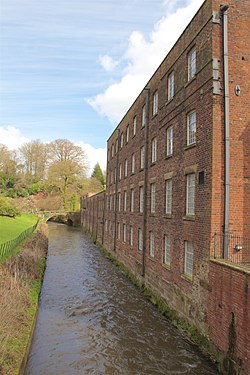 | |
| Owner | Samuel Greg |
|---|---|
| Further ownership |
|
| Coordinates | 53°20′38″N 2°14′58″W / 53.34390°N 2.24950°W |
| Construction | |
| Built | 1784 |
| Renovated |
|
| Floor count | 5 |
| Power | |
| Date | 1796, 1810 |
| Engine maker | Boulton & Watt |
| Water Power | |
| Diameter / width of water wheel | 32 feet (9.8 m) / 21 feet (6.4 m) |
| Equipment | |
| Mule Frames | |
Listed Building – Grade II* | |
| Official name | Quarry Bank Mill |
| Designated | 30 March 1951 |
| Reference no. | 1237687 |
Quarry Bank Mill (also known as Styal Mill) in Styal, Cheshire, England, is one of the best preserved textile factories of the Industrial Revolution. Built in 1784, the cotton mill is recorded in the National Heritage List for England as a designated Grade II* listed building.[1] Quarry Bank Mill was established by Samuel Greg, and was notable for innovations both in machinery and also in its approach to labour relations, the latter largely as a result of the work of Greg's wife, Hannah Lightbody. The family took a somewhat paternalistic attitude toward the workers, providing medical care for all and limited education to the children, but all laboured roughly 72 hours per week until 1847 when a new law shortened the hours.[2][3]
Greg also built housing for his workers, in a large community now known as Styal Estate. Some were conversions of farm houses, or older residences but 42 new cottages, including the Oak Cottages (now Grade II Listed), were built in the 1820s when the mill was being expanded.[4][5]
The National Trust, which runs the mill and Styal Estate as a museum that is open to the public, calls the site "one of Britain's greatest industrial heritage sites, home to a complete industrial community".[6] According to the Council of Europe, the mill with Styal village make up "the most complete and least altered factory colony of the Industrial Revolution. It is of outstanding national and international importance".[7]
- ^ Historic England. "Quarry Bank Mill (1237687)". National Heritage List for England. Retrieved 11 September 2013.
- ^ Historical Guide to the Apprentice House, Quarry Bank Professor Hannah Barker, U of Manchester
- ^ Professor Hannah Barker, U of Manchester
- ^ Historical Guide to Styal Village and 13 Oak Cottages, Quarry Bank, Professor Hannah Barker, University of Manchester
- ^ Historic England. "Oak Cottages (Grade II) (1222362)". National Heritage List for England. Retrieved 23 June 2021.
- ^ "Quarry Bank". National Trust. Retrieved 2 July 2020.
- ^ "Quarry Bank Mill". European Route of Industrial Heritage. Council of Europe. Retrieved 23 June 2021.